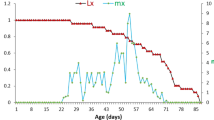Summary
Stage-specific mortality rates and mortality factors for the web-building spiderAgelena limbata, which is suggested to be food-limited, were studied, and the relationship between body size of spiders and survivorship for instar 3 to adults was examined. The mortality rate of the egg sac stage including eggs, deutova (prenymphal stage), and overwintering instar 1 nymphs was low. The low mortality of this stage was partly due to maternal care that reduced the mortality caused by predation and/or abiotic factors. From emergence of instar 1 nymphs from egg sacs to reproduction, the stagespecific mortality rates were almost constant, 32–47%, and the time-specific mortality rates were also constant. These results suggest a Deevey (1947) type II survivorship curve inA. limbata, in contrast to other reports on the wandering or burrowing spiders which suggested type III curves. Important mortality factors for nymphs and adults were parasitism by an ichneumonid wasp and predation by spiders. There were great variations in body size (carapace width) ofA. limbata in the field. Smaller individuals survived at a lower rate to the next stage than larger individuals. This tendency was clearer for the population living under poorer prey availability.A. limbata was unlikely to starve to death in the field because every stage ofA. limbata could survive starvation for a long time in the laboratory, 22–65 days on average. I suggest that the size-dependent survivorship of this spider is associated with vulnerability of smaller individuals to parasitism and predation.
Similar content being viewed by others
References
Anderson JF (1974) Responses to starvation in the spidersLycosa lenta Hentz andFilistata hibernalis (Hentz). Ecology 55:576–585
Calow P, Townsend CR (1981) Energetics, ecology and evolution. In: Townsend CR, Calow P (eds) Physiological Ecology: An Evolutionary Approach to Resource Use. Blackwell, Oxford, pp 3–19
Deevey DS Jr (1947) Life tables for natural populations of animals. Q Rev Biol 22:283–314
Edgar WD (1971) Seasonal weight changes, age structure, natality and mortality in the wolf spiderPardosa lugubris Walck in Central Scotland. Oikos 22:84–92
Gertsch WJ (1979) American Spiders, 2nd edn. Van Nostrand Reinhold, New York
Humphreys WF (1976) Population dynamics of an Australian wolf spider,Geolycosa godeffroyi (Koch 1865) (Araneae: Lycosidae). J Anim Ecol 45:59–80
McQueen DJ (1978) Field studies of growth, reproduction, and mortality in the burrowing wolf spiderGeolycosa domifex (Hancock). Can J Zool 56:2037–2049
McQueen DJ (1983) Mortality patterns for a population of burrowing wolf spiders,Geolycosa domifex (Hancock), living in southern Ontario. Can J Zool 61:2758–2767
Miyashita K (1968a) Quantitative feeding biology ofLycosa T-insignita Boes. et Str. (Araneae: Lycosidae). Bull Natl Inst Agr Sci C No. 22:329–344
Miyashita K (1968b) Growth and development ofLycosa T-insignita Boes. et Str. (Araneae: Lycosidae) under different feeding conditions. Appl Entomol Zool 3:81–88
Miyashita T (1986) Growth, egg production, and population density of the spider,Nephila clavata in relation to food conditions in the field. Res Popul Ecol 28:135–149
Olive CW (1982) Behavioral response of a sit-and-wait predator to spatial variation in foraging gain. Ecology 63:912–920
Riechert SE (1981) The consequences of being territorial: Spiders, a case study. Am Nat 117:871–892
Tanaka K (1984) Rate of predation by a kleptoparasitic spider,Argyrodes fissifrons, upon a large host spider,Agelena limbata. J Arachnol 12:363–367
Tanaka K (1989) Energetic cost of web construction and its effect on web relocation in the web-building spiderAgelena limbata. Oecologia 81:459–464
Tanaka K (1991) Food consumption and diet composition of the web-building spiderAgelena limbata in two habitats. Oecologia 86:8–15
Turnbull AL (1964) The search for prey by a web-building spiderAchaearanea tepidariorum (C.L. Koch) (Araneae: Theridiidae). Can Entomol 96:568–579
Wise DH (1975) Food limitation of the spiderLinyphia marginata: Experimental field studies. Ecology 56:637–646
Wise DH (1979) Effects of an experimental increase in prey abundance upon the reproductive rates of two orb-weaving spider species (Araneae: Araneidae). Oecologia 41:289–300
Author information
Authors and Affiliations
Rights and permissions
About this article
Cite this article
Tanaka, K. Size-dependent survivorship in the web-building spiderAgelena limbata . Oecologia 90, 597–602 (1992). https://doi.org/10.1007/BF01875456
Received:
Accepted:
Issue Date:
DOI: https://doi.org/10.1007/BF01875456




